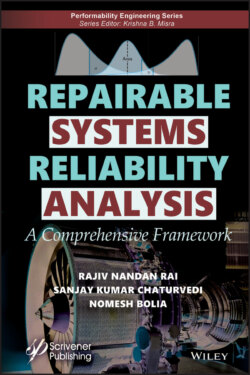Repairable Systems Reliability Analysis

Реклама. ООО «ЛитРес», ИНН: 7719571260.
Оглавление
Rajiv Nandan Rai. Repairable Systems Reliability Analysis
Table of Contents
List of Tables
List of Illustrations
Guide
Pages
Repairable Systems Reliability Analysis. A Comprehensive Framework
Series Editor Preface
Preface
List of Tables
List of Figures
1 Introduction to Repairable Systems. 1.1 Introduction
1.2 Perfect, Minimal, and Imperfect Repairs
1.3 Summary
References
2 Repairable Systems Reliability Analysis: Non-Parametric. 2.1 Introduction
2.2 Mean Cumulative Function
Example 2.1
2.3 Construction of MCF Plot and Confidence Bounds: Exact Age Data. 2.3.1 MCF Construction: Exact Age Data
Example 2.2. [6]
Example 2.3. [6]
2.3.2 Confidence Bounds on MCF: Exact Age Data
2.3.3 Construction of MCF Plot and Confidence Bounds: Grouped Data
2.3.4 Confidence Bounds on MCF: Grouped Data
Example 2.4. [4]
2.4 Case Study: ROV System
2.5 Interval Age Analysis. 2.5.1 MCF With All Types of Failure Modes Combined
2.5.2 MCF for Individual Failure Modes
2.5.3 Exact Age Analysis
2.6 Summary and Conclusion
Exercises
References
Note
3 Repairable Systems Reliability Analysis: Parametric. 3.1 Introduction
3.2 Basic Terminologies
3.3 Parametric Analysis Approaches. 3.3.1 Renewal Process
3.3.2 Non-Homogeneous Poisson Process (NHPP)
Example 3.1
Solution
Example 3.2
3.3.3 Generalized Renewal Process (GRP)
3.3.3.1 ARA Models
3.3.3.2 Kijima-I Model
3.3.3.3 Kijima-II Model
3.3.3.4 Virtual Age–Based Reliability Metrics
Solved Examples. Example 3.3
Example 3.4. [7]
Example 3.5. [7]
3.3.4 Summary
Exercises
References
Further Reading
ARI Models
4 Goodness-of-Fit Tests for Repairable Systems. 4.1 Introduction
4.2 Mann’s Test for the Weibull Distribution
Example 4.1
4.3 Laplace Trend Test
Example 4.2
4.4 GOF Models for Power Law Process
4.4.1 Crow/AMSAA Test
4.4.2 Common Beta Hypothesis (CBH) Tests
Example 4.3
4.4.3 CVM Test
Example 4.4
4.5 GOF Model for GRP Based on Kijima-I Model
Example 4.5
4.6 Summary
Exercises
References
5 Maintenance Modeling in Repairable Systems. 5.1 Introduction to Maintenance Policies Using Kijima Virtual Age Model
5.2 Need for HFRC Threshold
5.3 Reliability-Based Methodology for Optimal Maintenance Policies in MA
5.3.1 Reliability-Based Threshold Model for HFRC
5.3.1.1 Review of Present Maintenance Policy for HFRCs
Example 5.1
Example 5.2
5.4 Availability-Based HFRC Analysis
5.4.1 Availability-Based Criteria for HFRC (BB Approach)
5.4.1.1 Review of Overhaul Cycle (BB Approach)
Example 5.3
Example 5.4
5.4.2 Availability-Based HFRC Threshold Model Considering FMs
5.4.2.1 Maintenance Strategy for HFRCs With FM Approach
5.4.2.2 TBO Model Considering FMs
Example 5.5
5.5 Summary
Exercises
References
6 FMEA for Repairable Systems Based on Repair Effectiveness Index. 6.1 Introduction
6.2 A Brief Overview on Performing FMEA
6.2.1 System Definition
6.2.2 Identification of Failure Modes
6.2.3 Determination of Cause
6.2.4 Assessment of Effect
6.2.5 Classification of Severity (S)
6.2.6 Estimation of Probability of Occurrence (O)
6.2.7 Detection
6.2.8 Computation of Conventional RPN
6.2.9 Determination of Corrective Action
6.3 Estimating RPNs Through the Modified Approach [15]
6.4 Corrective Actions
6.5 Summary
References
7 An Integrated Approach to Weapon Procurement Systems. 7.1 Introduction
7.2 Analytic Network Process Model
7.3 AP Index and AP Value Estimation
7.3.1 Analytic Hierarchy Process Model
7.3.2 AP Index Estimation
7.3.3 Sample AP Index Estimation
7.3.4 AP Value Estimation
7.4 Formation of an ACU
7.4.1 Attack Model
7.4.2 Defense Model
7.4.3 Illustrative Example
7.5 Summary
References
8 Throughput Analysis of the Overhaul Line of a Repair Depot. 8.1 Introduction
8.2 Basic Definitions, Parameters, and Relationships
8.3 Variability
8.3.1 Measures and Classes of Variability
8.3.2 Causes of Variability
8.3.3 Variability from Preemptive Outages (Breakdowns)
8.3.4 Variability in Flows
8.3.5 Variability Interactions Queuing
8.3.5.1 The M/M/1 Queue
8.3.5.2 The G/G/1 Queue
8.4 Process Batching
8.5 System Flow and Parameters
8.6 System Analysis and Discussion
8.6.1 Component 1: LPCR Blades
8.6.2 Component 2: CCOC
8.6.3 Component 3: LPTR Blades
8.7 Summary
References
Appendix A. The Saaty Rating Scale
Pairwise Comparisons and Estimation of Weights for ANP
Appendix B
Unweighted Super-Matrix (Part 1)
Unweighted Super-Matrix (Part 2)
Weighted Super-Matrix (Part 1)
Weighted Super-Matrix (Part 2)
Limit Super-Matrix (Part 1)
Limit Super-Matrix (Part 2)
Appendix C
Pairwise Comparisons and Estimation of Weights for AHP
Appendix D. F Distribution Table
Appendix E. Normal Distribution Table
Appendix F. Chi Square Table
Appendix G. Critical Values for Cramér-von Mises Test
Index
Also of Interest. Check out these published and forthcoming titles in the Performability Engineering Series
WILEY END USER LICENSE AGREEMENT
Отрывок из книги
Scrivener Publishing 100 Cummings Center, Suite 541J Beverly, MA 01915-6106
.....
The renewal and homogeneous Poisson processes (HPPs) followed by an exhaustive description of NHPP are covered in Chapter 3 along with solved examples. Thereafter, the chapter brings out a detailed description of ARA and ARI models along with their applicability in maintenance. The chapter also derives the maximum likelihood estimators (MLEs) for Kijima virtual age models with the help of GRP. The models are demonstrated with the help of suitable examples.
Chapter 4 provides various goodness-of-fit (GOF) tests for repairable systems and their applications with examples.
.....